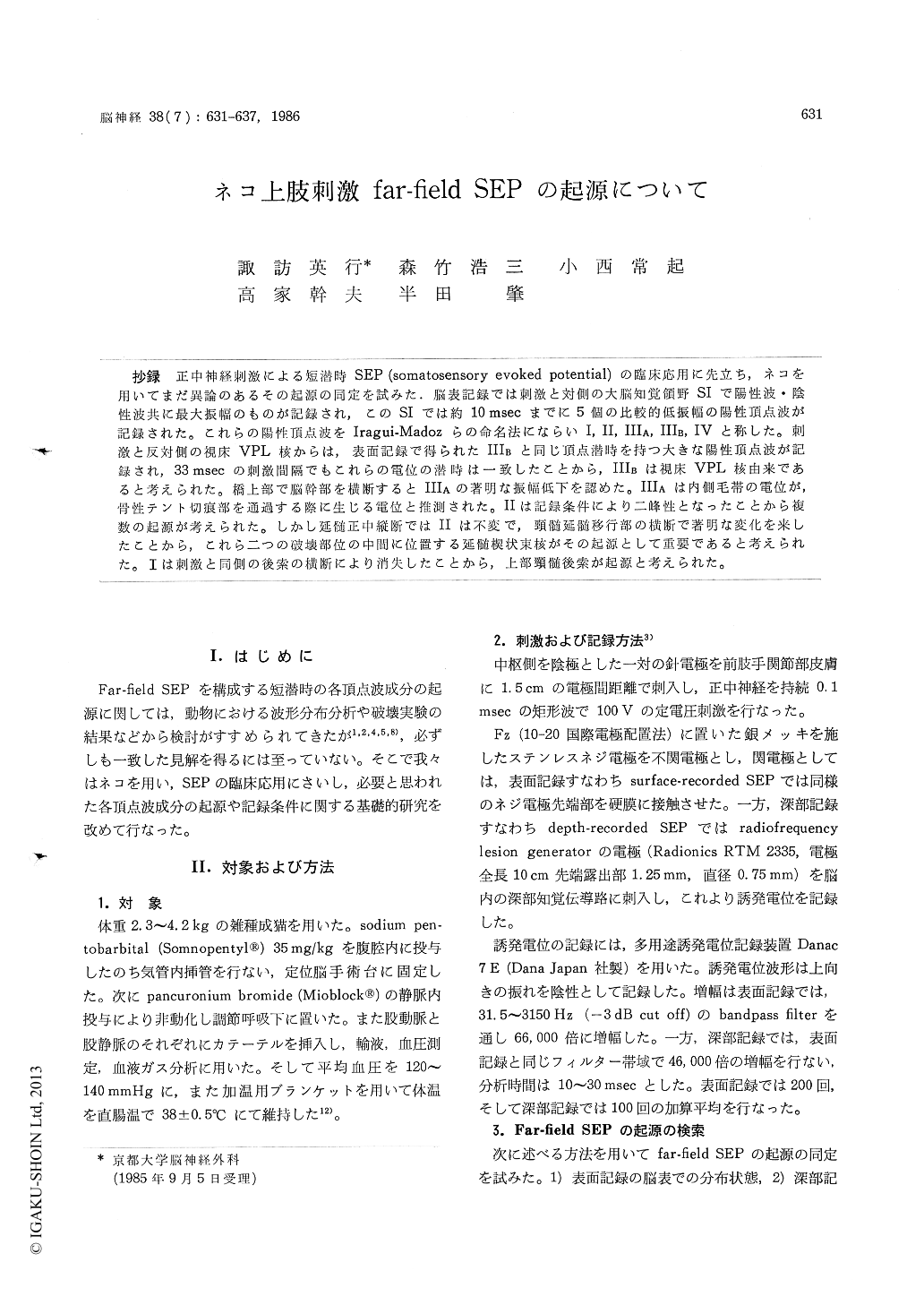Japanese
English
- 有料閲覧
- Abstract 文献概要
- 1ページ目 Look Inside
抄録 正中神経刺激による短潜時SEP (somatosensory evoked potential)の臨床応用に先立ち,ネコを用いてまだ異論のあるその起源の同定を試みた.脳表記録では刺激と対側の大脳知覚領野SIで陽性波・陰性波共に最大振幅のものが記録され,このSIでは約10 msecまでに5個の比較的低振幅の陽性頂点波が記録された。これらの陽性頂点波をIragui-Madozらの命名法にならいI II, IIIA, IIIB, IVと称した。刺激と反対側の視床VPL核からは,表面記録で得られたIIIBと同じ頂点潜時を持つ大きな陽性頂点波が記録され,33msecの刺激間隔でもこれらの電位の潜時は一致したことから, IIIBは視床VPL核由来であると考えられた。橋上部で脳幹部を横断するとIIIAの著明な振幅低下を認めた。 IIIAは内側毛帯の電位が,骨性テント切痕部を通過する際に生じる電位と推測された。IIは記録条件により二峰性となったことから複数の起源が考えられた。しかし延髄正中縦断ではIIは不変で,頸髄延髄移行部の横断で著明な変化を来したことから,これら二つの破壊部位の中間に位置する延髄模状東核がその起源として重要であると考えられた。Iは刺激と同側の後索の横断により消失したことから,上部頸髄後索が起源と考えられた。
Results of various experimental and clinical stu-dies on the origins of somatosensory evoked po-tentials (SEP) suggested that the far-field and early near-field potentials are generated primarily from sources within the dorsal column-medial lemniscal system. However, there are a few studies where direct depth recordings of SEP were performed and they were compared with surface-recorded SEP components.
The purpose of this investigation is to determine the origins of somatosensory far-field and early near-field evoked potentials in cat by the analysis of distribution mode of surface-recorded SEPs, the comparison of depth recorded with surface-recorded SEPs and by the study of SEP changes caused by serial destruction of the structures relating to sen-sory pathway. A complex patterns of evoked potentials were recorded from cerebral epidural surface in cat by forelimb median nerve stimula-tion. The largest positive to negative slope was recorded from the epidural electrode on the sen-sory cortex contralateral to the stimulation. Five small positive potentials could be identified on the positive slope. We labeled these potentials as T, II, IIIA, IIIB, IV according to the report by Iragui-Madoz.
The largest positive potential recorded from the VPL was coincident with the surface-recorded III in latency at different interstimulus intervals. After transection of the midbrain-pons junction, IIIA remained unchanged, and the following waves disappeared. However, IIIA decreased in latency and markedy decreased in amplitude after transec-tion of the pons at its rostral level. IIIA seems to be generated from the medial lemniscus at the level of osseous cerebellar tentorium.
A peak latency of surface-recorded II was al-most coincident in latency with the second nega-tive potential recorded on the dorsal dural surface of C 3 segment of the spinal cord. Follwing me-dian longitudinal section of the medulla oblongata, IIIA disappeared completely but II remained un-changed. After transection of the spino-medullary junction, however, II increased in latency. II was considered to be complex in its origin but seems to be generated mainly from the cuneate nucleus.
The first negative potential recorded on the dorsal dural surface of C 3 segment of the spinal cord was coincident in latency with surface-recorded I. Following transection of the dorsal column ipsila-teral to the stimulation, I and the following peaks completely disappeared. These results suggest that the origin of I locates in dorsal column of spinal cord.
By the median longitudinal section of Cl and C 2 segment of the spinal cord, no change occur-red in SEP. This result suggests that the spino-cervico-thalamic tract does not contribute to SEP.

Copyright © 1986, Igaku-Shoin Ltd. All rights reserved.


